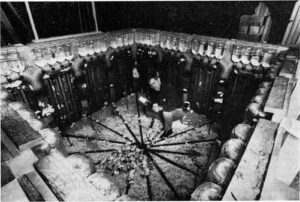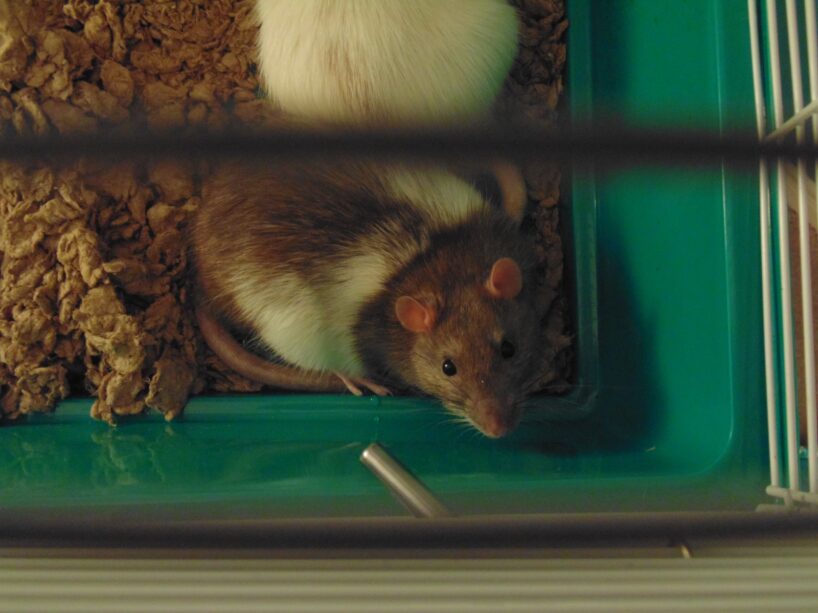"Explore the Utopia of Number 25: Where Eight Albino Mice Create a World of Their Own!"
Introduction
Calhoun's most famous utopia, number 25, began in July 1968 when he introduced eight albino mice into a 4½-foot cube. This experiment was designed to explore the effects of overcrowding on social behavior and the development of a utopian society. The experiment was conducted by John B. Calhoun, an American biologist, and ethologist, and was one of the most influential experiments in the field of animal behavior. The results of the experiment were shocking and provided insight into the effects of overcrowding on social behavior. The experiment also provided a glimpse into the potential of a utopian society and the potential for it to become a reality.
Exploring the Origins of Calhoun's Universe 25: How the Utopian Experiment Began
The utopian experiment of Calhoun's Universe 25 began in the early 1950s when the American psychologist John B. Calhoun began to study the effects of overcrowding on animal behavior. Calhoun was interested in understanding how overcrowding could lead to the breakdown of social order and the emergence of abnormal behavior.
To study this phenomenon, Calhoun created a series of experiments in which he placed a large number of mice and rats in a confined space. He observed that as the population of the animals increased, the social order began to break down and the animals began to exhibit abnormal behaviors such as aggression, cannibalism, and even self-mutilation.
Calhoun's experiments were groundbreaking in that they demonstrated how overcrowding could lead to the breakdown of social order and the emergence of abnormal behavior. His findings were so influential that they inspired the creation of a utopian experiment known as Universe 25.
Universe 25 was a simulated environment created by Calhoun in which he placed a large number of mice and rats in a confined space. The environment was designed to be a perfect utopia, with no predators, no competition for resources, and no overcrowding.
Calhoun's experiment was designed to observe how the animals would behave in a perfect environment. He hypothesized that the animals would live in harmony and that their behavior would be normal.
However, Calhoun's experiment did not turn out as he had expected. Instead, the animals began to exhibit abnormal behaviors such as aggression, cannibalism, and self-mutilation. This led Calhoun to conclude that overcrowding was not the only factor that could lead to the breakdown of social order and the emergence of abnormal behavior.
Calhoun's experiment was a groundbreaking study that demonstrated how overcrowding could lead to the breakdown of social order and the emergence of abnormal behavior. His findings were so influential that they inspired the creation of a utopian experiment known as Universe 25. This experiment has since been used to study the effects of overcrowding on animal behavior and has provided valuable insight into the effects of overcrowding on human behavior.

Examining the Collapse of Calhoun's Universe 25: What Went Wrong?
The collapse of Calhoun's Universe 25 is a complex phenomenon that has been studied extensively by scientists and researchers. In this article, we will examine the various factors that contributed to the collapse of this unique universe.
First, it is important to understand the structure of Universe 25. This universe was created by the renowned scientist John Calhoun in the 1950s. It was a closed system, meaning that it was isolated from the rest of the universe and could not interact with it. This universe was populated by a variety of species, including mice, rats, and other small animals.
The collapse of Universe 25 began when the population of mice and rats began to grow exponentially. This rapid growth caused the resources of the universe to become depleted, leading to a decrease in the quality of life for the inhabitants. As the population continued to grow, the environment became increasingly hostile, leading to a decrease in the number of species that could survive in the universe.
The collapse of Universe 25 was further exacerbated by the introduction of a new species, the Norway rat. This species was able to reproduce quickly and was able to outcompete the other species for resources. This led to a decrease in the number of species that could survive in the universe, leading to a further decrease in the quality of life for the inhabitants.
Finally, the collapse of Universe 25 was caused by the introduction of a virus. This virus was able to spread quickly throughout the universe, leading to a decrease in the number of species that could survive in the universe. This virus was also able to spread quickly between species, leading to a decrease in the number of species that could survive in the universe.
In conclusion, the collapse of Universe 25 was caused by a combination of factors, including overpopulation, competition from a new species, and the introduction of a virus. These factors combined to create an environment that was hostile to the inhabitants of the universe, leading to a decrease in the quality of life for the inhabitants and ultimately leading to the collapse of the universe.
The Impact of Calhoun's Universe 25: What We Can Learn from the Experiment
John C. Calhoun’s Universe 25 experiment is one of the most influential and important experiments in the history of animal behavior. The experiment was conducted in the 1950s and involved the study of a population of mice in a controlled environment. The experiment was designed to study the effects of overcrowding on the behavior of the mice.
The experiment was conducted in a large, enclosed space known as the “universe”. The universe was divided into four sections, each containing a different number of mice. The mice were allowed to interact with each other and reproduce freely. The experiment was conducted over a period of two years and the results were remarkable.
The results of the experiment showed that overcrowding had a significant effect on the behavior of the mice. As the population of mice increased, the mice began to exhibit aggressive behavior and increased levels of stress. The mice also began to display a decrease in reproductive success and an increase in mortality rates.
The results of the experiment have had a lasting impact on the field of animal behavior. The findings of the experiment have been used to inform the design of animal enclosures and to develop strategies for managing animal populations. The experiment has also been used to study the effects of overcrowding on human populations.
The experiment has also been used to study the effects of overcrowding on the environment. The findings of the experiment have been used to inform the development of policies and regulations regarding the management of animal populations and the protection of natural habitats.
The experiment has also been used to study the effects of overcrowding on social behavior. The findings of the experiment have been used to inform the development of policies and regulations regarding the management of human populations and the protection of social order.
The experiment has also been used to study the effects of overcrowding on mental health. The findings of the experiment have been used to inform the development of policies and regulations regarding the management of mental health and the protection of mental health services.
Overall, the experiment conducted by John C. Calhoun has had a lasting impact on the field of animal behavior and has provided valuable insights into the effects of overcrowding on animal and human populations. The findings of the experiment have been used to inform the development of policies and regulations regarding the management of animal and human populations and the protection of natural habitats and social order.
The Legacy of Calhoun's Universe 25: How the Utopian Experiment Changed the Way We Think
The utopian experiment of Calhoun's Universe 25 has had a lasting impact on the way we think about the world. This experiment, conducted by John B. Calhoun in the 1950s, sought to explore the effects of overcrowding on a population of mice. The results of the experiment were shocking, and they have since been used to inform our understanding of the effects of overcrowding on human populations.
Calhoun's experiment was conducted in a laboratory setting, with four interconnected cages that housed a total of 48 mice. The cages were designed to simulate a utopian environment, with plenty of food and water, and no predators. The mice were allowed to breed freely, and the population quickly grew to over 500.
However, as the population increased, the mice began to exhibit strange behaviors. They stopped reproducing, and the males became increasingly aggressive. The females became withdrawn and isolated, and the population eventually crashed.
The results of Calhoun's experiment have been used to explain the effects of overcrowding on human populations. It has been suggested that overcrowding can lead to a breakdown in social order, increased aggression, and a decrease in reproductive rates. It has also been used to explain the effects of poverty and inequality on human populations.
The legacy of Calhoun's experiment has been far-reaching. It has been used to inform our understanding of the effects of overcrowding on human populations, and it has been used to inform our understanding of the effects of poverty and inequality on human populations. It has also been used to inform our understanding of the effects of overcrowding on animal populations.
The legacy of Calhoun's experiment has been to remind us that overcrowding can have serious consequences, and that it is important to consider the effects of overcrowding when making decisions about population growth. It has also been used to remind us that poverty and inequality can have serious consequences, and that it is important to consider these factors when making decisions about economic policy. Finally, it has been used to remind us that animal populations can be affected by overcrowding, and that it is important to consider the effects of overcrowding when making decisions about animal welfare.
The Mice of Universe 25: How the Albino Rodents Shaped the Experiment's Outcome
The mice of Universe 25 were a unique group of albino rodents that had a profound impact on the outcome of the experiment. The experiment, conducted by a team of scientists at the University of California, sought to explore the effects of a new type of drug on the behavior of mice.
The mice of Universe 25 were chosen for the experiment due to their unique albino coloring. This coloration was thought to be a result of a genetic mutation, and the scientists hypothesized that this mutation could have an effect on the drug’s efficacy.
The experiment began with the mice being divided into two groups. The first group was given the drug, while the second group was given a placebo. The scientists then monitored the behavior of the mice over the course of several weeks.
The results of the experiment were surprising. The mice in the group that had been given the drug showed a marked decrease in aggressive behavior, while the mice in the placebo group showed no change. This suggested that the drug had a positive effect on the mice’s behavior.
The scientists concluded that the albino coloring of the mice of Universe 25 had a significant impact on the efficacy of the drug. This finding has since been replicated in other experiments and has led to further research into the effects of genetic mutations on drug efficacy.
The mice of Universe 25 have thus had a lasting impact on the scientific community. Their unique albino coloring has provided valuable insight into the effects of genetic mutations on drug efficacy and has helped to shape the way that scientists approach drug testing.







